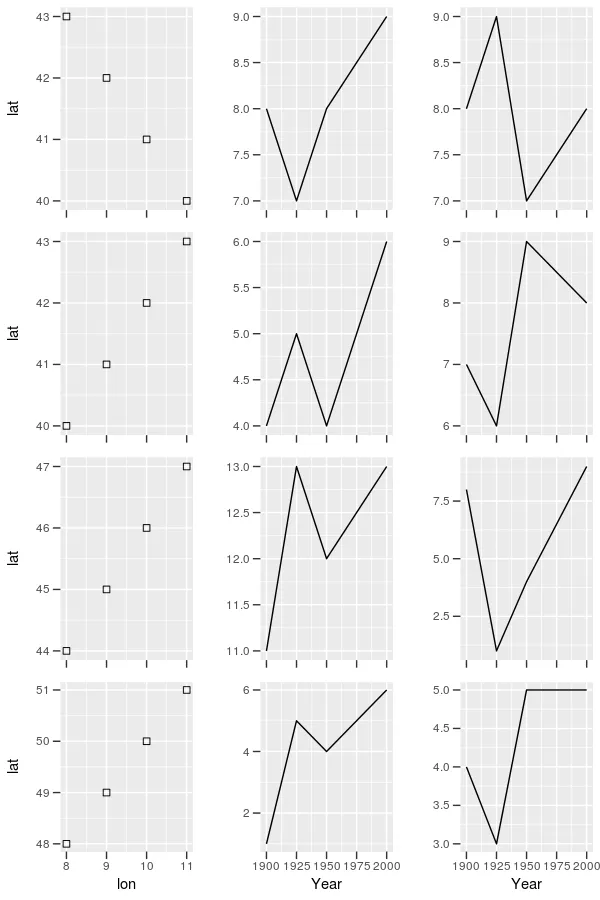我有一个具有4x3面板结构的ggplot2。每列面板共享相同的x轴文本和标题。我希望所有面板的大小相同,但是当我将x轴标题和文本添加到底部行时,会导致面板重新调整大小。如何确保面板大小相等?以下是可重现的示例:
library(ggmap)
library(maps)
library(ggplot2)
BII.TEMP.SUMMER=data.frame("Year"=c(1851, 1901, 1951, 2001), "Temp"=c(8,7,8,9))
BII.PPT.SUMMER=data.frame("Year"=c(1851, 1901, 1951, 2001), "PPT"=c(8,7,8,9))
SCAN.TEMP.SUMMER=data.frame("Year"=c(1851, 1901, 1951, 2001), "Temp"=c(8,7,8,9))
SCAN.PPT.SUMMER=data.frame("Year"=c(1851, 1901, 1951, 2001), "PPT"=c(8,7,8,9))
CE.TEMP.SUMMER=data.frame("Year"=c(1851, 1901, 1951, 2001), "Temp"=c(8,7,8,9))
CE.PPT.SUMMER=data.frame("Year"=c(1851, 1901, 1951, 2001), "PPT"=c(8,7,8,9))
TEMP.SUMMER=data.frame("Year"=c(1851, 1901, 1951, 2001), "Temp"=c(8,7,8,9))
PPT.SUMMER=data.frame("Year"=c(1851, 1901, 1951, 2001), "PPT"=c(8,7,8,9))
BII.coords=data.frame(lon=c(-6.9532,-7.9925,-2.5036,-8.2569,-6.5487,-7.4083,-2.0369,-2.175,-6.1921),
lat=c(53.3653,53.0807,55.0875,53.1865,54.8862,53.7667,54.4253,54.0964,55.0848))
CE.coords=data.frame(lon=c(16.5872,13.8494,6.2317,21.2201,15.3602,17.9821,18.3098,
9.8544,22.4419,6.1736,16.4785,18.0833,24.545),
lat=c(53.8078,53.0558,46.5397,53.8726,50.8519,53.5918,53.188,
46.49,54.3314,46.5667,54.3619,54.4244,47.5739))
SCAN.coords=data.frame(lon=c(17.3667,18.6833,18.4333,22.7833,19.5828,10.1896,26.25,19.0484),
lat=c(60.0167,59.9667,59.6333,60.7833,64.1647,56.8391,58.8667,68.3568))
BII.MAP=data.frame(xmin=-10.31, xmax=-0.93, ymin=51.44, ymax=55.22)
thismap=map_data("world")
P1=ggplot()+geom_polygon(data=thismap, aes(x=long, y=lat, group=group), color="lightgray", fill="white")+
coord_fixed(xlim=c(-11, 30), ylim=c(40, 70), ratio=1.0)+
geom_rect(data=BII.MAP, aes(xmin=xmin, xmax=xmax, ymin=ymin, ymax=ymax),
inherit.aes=FALSE, colour="black", alpha=0.1)+
geom_point(data=BII.coords, aes(lon, lat), inherit.aes=FALSE, color="black", size=2, shape=0)+
theme(panel.grid.major=element_blank(), panel.grid.minor=element_blank(), plot.title=element_text(color="black", size=10, face="bold"),
axis.text.x=element_blank(), axis.title.x=element_blank(), axis.ticks.length=unit(0.2, "cm"))+
ggtitle("Britain & Ireland")
SCAN.MAP=data.frame(xmin=8.44, xmax=27.19, ymin=55.25, ymax=68.56)
thismap=map_data("world")
P4=ggplot()+geom_polygon(data=thismap, aes(x=long, y=lat, group=group), color="lightgray", fill="white")+
coord_fixed(xlim=c(-11, 30), ylim=c(40, 70), ratio=1.0)+
geom_point(data=SCAN.coords, aes(lon, lat), inherit.aes=FALSE, color="black", size=2, shape=1)+
geom_rect(data=SCAN.MAP, aes(xmin=xmin, xmax=xmax, ymin=ymin, ymax=ymax),
inherit.aes=FALSE, colour="black", alpha=0.1)+
theme(panel.grid.major=element_blank(), panel.grid.minor=element_blank(), plot.title=element_text(color="black", size=10, face="bold"),
axis.text.x=element_blank(), axis.title.x=element_blank(), axis.ticks.length=unit(0.2, "cm"))+
ggtitle("Scandinavia")
CE.MAP=data.frame(xmin=4.69, xmax=25.32, ymin=45.73, ymax=55.22)
thismap=map_data("world")
P7=ggplot()+geom_polygon(data=thismap, aes(x=long, y=lat, group=group), color="lightgray", fill="white")+
coord_fixed(xlim=c(-11, 30), ylim=c(40, 70), ratio=1.0)+
geom_point(data=CE.coords, aes(lon, lat), inherit.aes=FALSE, color="black", size=2, shape=2)+
geom_rect(data=CE.MAP, aes(xmin=xmin, xmax=xmax, ymin=ymin, ymax=ymax),
inherit.aes=FALSE, colour="black", alpha=0.1)+
theme(panel.grid.major=element_blank(), panel.grid.minor=element_blank(), plot.title=element_text(color="black", size=10, face="bold"),
axis.text.x=element_blank(), axis.title.x=element_blank(), axis.ticks.length=unit(0.2, "cm"))+
ggtitle("Continental Europe")
MAP=data.frame(xmin=-10.31, xmax=27.19, ymin=45.73, ymax=68.56)
thismap=map_data("world")
P10=ggplot()+geom_polygon(data=thismap, aes(x=long, y=lat, group=group), color="lightgray", fill="white")+
coord_fixed(xlim=c(-11, 30), ylim=c(40, 70), ratio=1.0)+
geom_point(data=BII.coords, aes(lon, lat), inherit.aes=FALSE, color="black", size=2, shape=0)+
geom_point(data=SCAN.coords, aes(lon, lat), inherit.aes=FALSE, color="black", size=2, shape=1)+
geom_point(data=CE.coords, aes(lon, lat), inherit.aes=FALSE, color="black", size=2, shape=2)+
geom_rect(data=MAP, aes(xmin=xmin, xmax=xmax, ymin=ymin, ymax=ymax),
inherit.aes=FALSE, colour="black", alpha=0.1)+
theme(panel.grid.major=element_blank(), panel.grid.minor=element_blank(), plot.title=element_text(color="black", size=10, face="bold"),
axis.ticks.length=unit(0.2, "cm"))+
ggtitle("All Sites")
P2=ggplot(BII.TEMP.SUMMER, aes(Year,Temp))+
geom_line(color="gray75")+ylim(12.9,16.6)+geom_smooth(color="red", se=FALSE)+ggtitle("Temperatures (°C)")+
geom_vline(xintercept=1914, col="purple4", linetype=2)+annotate("text", x=1916, y=12.9, label="Dry Shift", col="purple4")+
theme(panel.grid.major=element_blank(), panel.grid.minor=element_blank(), plot.title=element_text(color="red", size=10, face="bold"),
axis.text.x=element_blank(), axis.title.x=element_blank(), axis.title.y=element_blank(), axis.ticks.length=unit(0.2, "cm"))+
annotate("text", x=1935, y=16.6)
P3=ggplot(BII.PPT.SUMMER, aes(Year,PPT))+
geom_line(color="gray75")+ylim(88,428)+geom_smooth(color="blue", se=FALSE)+ggtitle("Precipitation (mm)")+
geom_vline(xintercept=1914, col="purple4", linetype=2)+annotate("text", x=1916, y=88, label="Dry Shift", col="purple4")+
theme(panel.grid.major=element_blank(), panel.grid.minor=element_blank(), plot.title=element_text(color="blue", size=10, face="bold"),
axis.text.x=element_blank(), axis.title.x=element_blank(), axis.title.y=element_blank(), axis.ticks.length=unit(0.2, "cm"))+
annotate("text", x=1935, y=428)
P5=ggplot(SCAN.TEMP.SUMMER, aes(Year,Temp))+
geom_line(color="gray75")+ylim(11.2,16.2)+geom_smooth(color="red", se=FALSE)+
theme(panel.grid.major=element_blank(), panel.grid.minor=element_blank(), plot.title=element_text(color="white", size=10, face="bold"),
axis.text.x=element_blank(), axis.title.x=element_blank(), axis.title.y=element_blank(), axis.ticks.length=unit(0.2, "cm"))+
annotate("text", x=1935, y=16.2)+
ggtitle("BLANK")
P6=ggplot(SCAN.PPT.SUMMER, aes(Year,PPT))+
geom_line(color="gray75")+ylim(144,359)+geom_smooth(color="blue", se=FALSE)+
theme(panel.grid.major=element_blank(), panel.grid.minor=element_blank(), plot.title=element_text(color="white", size=10, face="bold"),
axis.text.x=element_blank(), axis.title.x=element_blank(), axis.title.y=element_blank(), axis.ticks.length=unit(0.2, "cm"))+
annotate("text", x=1935, y=359)+
ggtitle("BLANK")
P8=ggplot(CE.TEMP.SUMMER, aes(Year,Temp))+
geom_line(color="gray75")+ylim(16.4,21.3)+geom_smooth(color="red", se=FALSE)+
theme(panel.grid.major=element_blank(), panel.grid.minor=element_blank(), plot.title=element_text(color="white", size=10, face="bold"),
axis.text.x=element_blank(), axis.title.x=element_blank(), axis.title.y=element_blank(), axis.ticks.length=unit(0.2, "cm"))+
annotate("text", x=1935, y=21.3)+
ggtitle("BLANK")
P9=ggplot(CE.PPT.SUMMER, aes(Year,PPT))+
geom_line(color="gray75")+ylim(144, 387)+geom_smooth(color="blue", se=FALSE)+
theme(panel.grid.major=element_blank(), panel.grid.minor=element_blank(), plot.title=element_text(color="white", size=10, face="bold"),
axis.text.x=element_blank(), axis.title.x=element_blank(), axis.title.y=element_blank(), axis.ticks.length=unit(0.2, "cm"))+
annotate("text", x=1935, y=387)+
ggtitle("BLANK")
P11=ggplot(TEMP.SUMMER, aes(Year,Temp))+
geom_line(color="gray75")+ylim(13.9,17.6)+geom_smooth(color="red", se=FALSE)+
theme(panel.grid.major=element_blank(), panel.grid.minor=element_blank(), plot.title=element_text(color="white", size=10, face="bold"),
axis.title.y=element_blank(), axis.ticks.length=unit(0.2, "cm"))+
annotate("text", x=1935, y=17.6)+
ggtitle("BLANK")
P12=ggplot(PPT.SUMMER, aes(Year,PPT))+
geom_line(color="gray75")+ylim(139,328)+geom_smooth(color="blue", se=FALSE)+
theme(panel.grid.major=element_blank(), panel.grid.minor=element_blank(), plot.title=element_text(color="white", size=10, face="bold"),
axis.title.y=element_blank(), axis.ticks.length=unit(0.2, "cm"))+
annotate("text", x=1935, y=328)+
ggtitle("BLANK")
plots <- list(P1, P2, P3, P4, P5, P6, P7, P8, P9, P10, P11, P12)
grobs <- list()
widths <- list()
#collect the widths for each grob of each plot
for (i in 1:length(plots)){
grobs[[i]] <- ggplotGrob(plots[[i]])
widths[[i]] <- grobs[[i]]$widths[2:5]
}
#use do.call to get the max width
maxwidth <- do.call(grid::unit.pmax, widths)
#asign the max width to each grob
for (i in 1:length(grobs)){
grobs[[i]]$widths[2:5] <- as.list(maxwidth)
}
# plot
#do.call("grid.arrange", c(grobs, ncol = 1))
do.call("grid.arrange", c(grobs, nrow = 4))


library(gridExtra)和grid.arrange(P1, P2, P3, P4, P5, P6, P7, P8, P9, P10, P11, P12, nrow=4)非常好,因为(在有工作图形的情况下)它很好地突出了不一致缩放的问题,即当最后一行图表具有x轴文本而其他行没有时。您可能考虑将其放回。 - krads